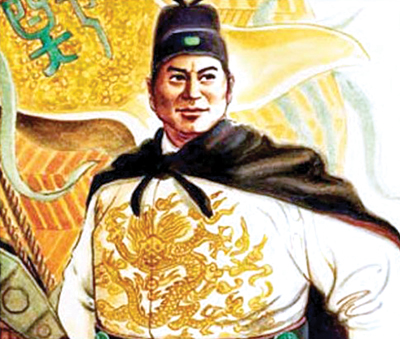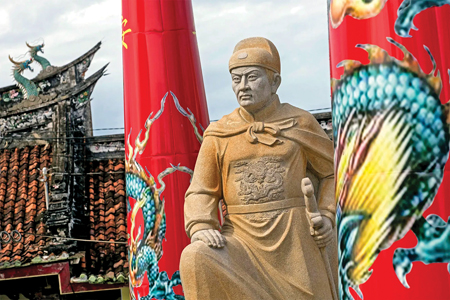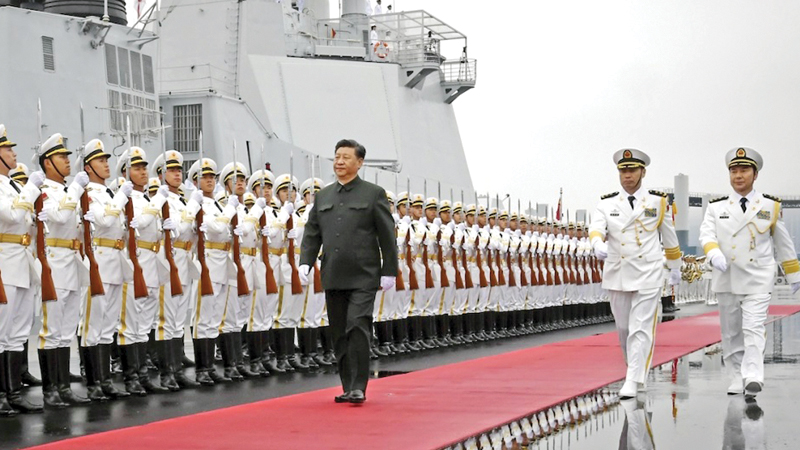China, which is currently challenging the dominance of the US in the Indo-Pacific region, had quit the maritime sphere in the 15th Century, deliberately opting to be a land power.
But after staying away from the oceans for 500 odd years, it is coveting them again in the same way as it did in its heyday of maritime activity from about 960 CE to 1435 CE.
According to the China Power Project of the US Centre for Strategic and International Studies (CSIS), China has undertaken sweeping efforts to modernise its navy since 2012. At the 18th Party Congress in 2012, the then-President Hu Jintao called upon China to become a “maritime power capable of safeguarding its maritime rights and interests.” President Xi Jinping reiterated this position in April 2018 when he said that “the task of building a powerful navy has never been as urgent as it is today.”
Naval force

Chinese Admiral Zheng He
China’s 2019 Defence White Paper outlined the need “to build a strong and modernised naval force that is capable of carrying out missions on the far seas.”
In other words, China is harking back to the days of the legendary Admiral Zheng He of the 15th Century.
According to the CSIS, around 2015, the Chinese Navy surpassed the US Navy in size. The People’s Liberation Army Navy (PLAN) continued to grow in the years since then. The U.S. Congressional Research Service estimates that the Chinese Navy consisted of 348 ships and submarines in 2021. The US Department of Defence (DoD) puts the figure at 355 vessels. By comparison, the deployable battle force of the US Navy comprised 296 vessels in 2021, US sources say.
“New ships are being put to sea at an impressive rate. Between 2017 and 2019, China reportedly built more vessels than India, Japan, Australia, France, and the United Kingdom combined. In 2021, China commissioned at least 28 ships, while the U.S. Navy was positioned to commission seven ships that year. Should China continue to commission ships at a similar rate, it could have 425 battle force ships by 2030,” the CSIS report says.
It quotes the RAND to say that over 70 percent of the PLAN fleet in 2017 was considered “modern,” up from less than 50 percent in 2010. China is also producing larger ships capable of accommodating advanced armaments and on-board systems.
The PLAN’s first Type 055 cruisers, for instance, entered service in 2019 and displaced between 4,000 to 5,000 more tons than the Type 052D destroyer, which entered service in 2014. The Type 055 is equipped with 112 vertical launch system (VLS) missile cells that can aid in area defence while escorting China’s aircraft carriers in blue waters.
Overall tonnage
China is also leading the world in terms of the overall tonnage of new ships being put to sea. The collective tonnage of the ships launched by China between 2014 and 2018 was an impressive 678,000 tons—larger than the aggregate tonnages of the navies of France and Spain combined, the report says.
However, the PLAN’s total tonnage remains less than that of the US Navy. As of 2018, the gap between the two navies was estimated at roughly three million tons. This difference is largely attributed to the United States fielding 11 aircraft carriers, each displacing approximately 100,000 tons, it adds.
China’s maritime past
According to the Cambridge History of China, it was during Sung dynastic period (960-1279 CE) that China emerged as a leading maritime power in terms of commodity exchange and technological progress particularly in shipbuilding. The Mongols, who captured the whole of China by 1279 under the leadership of Kublai Khan, also encouraged maritime trade even though they hailed from the landlocked Steppes.
Mongol rulers Chengiz Khan and Ogodei took over vast stretches of land up to the fringes of Europe. The Chagatai branch of the Chengiz Khan family clashed with the Sultans of Delhi in the 13th Century. The Ilkhanid dynasty of Mongols ruled over West Asia.
Indian diplomat and China expert Shyam Saran says in his book How China sees India and the World that the Mongol dominance of this vast stretch of land ensured peace for traders. Saran says that Chinese maritime trade enabled contacts to be established between China, and the Western and Eastern coasts of India and also Sri Lanka.
 Calicut, Cochin, and Quilon (Kollam) on the Kerala coast became hubs for Chinese ships, big and small, trading with a variety of countries. During the dynasty of Yuan (a Mongol dynasty which ruled China from 1272 to 1296 CE), there were 16 official missions to Quilon. Saran adds that the Chinese ships were not just trading vessels but were also armed with cannons to encounter any challenge on sea or land.
Calicut, Cochin, and Quilon (Kollam) on the Kerala coast became hubs for Chinese ships, big and small, trading with a variety of countries. During the dynasty of Yuan (a Mongol dynasty which ruled China from 1272 to 1296 CE), there were 16 official missions to Quilon. Saran adds that the Chinese ships were not just trading vessels but were also armed with cannons to encounter any challenge on sea or land.
The Yuan dynasty was brought down by a revolt which stemmed from an economic crisis created by floods and draught and also by a grandiose scheme to build a canal to link Beijing. The Mongol rulers got unpopular also because they, being Muslims, appointed Muslims in place of the indigenous Hans. The Mandarins, who were Han, were side lined. They were the traditional Chinese bureaucrats steeped in Confucian thought. They hated the Mongols, partly because the Mongols replaced recruitment to the civil service through a public examination. Rational recruitment through examinations had been the norm since the Sui dynasty (581-680 CE) which was a Han dynasty.
The revolt against the Mongols was led by Zhen Chongbi, an ex-bhikkhu. It resulted in the establishment of the Ming dynasty in 1368 CE. It was a Han dynasty. The Mings, ruling from Nanjing, a port on the Yangtze river, captured Sichuan and Yunnan.
It was in the Ming’s campaign in Yunnan that Zheng He, who later became China’s greatest seafarer and naval Admiral, entered the scene. A Mongol Muslim boy, Zheng He was captured, castrated and admitted to the imperial palace to serve the Emperor and his family. But Zhang He, the eunuch, rose to be an Admiral commanding an extraordinarily strong navy armed to the teeth. Under Zheng He, the Chinese Navy undertook seven foreign expeditions between 1405 and 1435 CE.
The Ming dynasty brought back the Mandarin-style of administration, but they did not stop maritime trade which flourished under the Mongols. In fact, maritime technologies improved under Ming rule with the help of Persian astronomers. Ibn Batuta (1304-1365), the Moroccan traveller had noticed large and small Chinese ships in Calicut and Quilon in Kerala.
After Zhen Chongbi, the next strong Ming Emperor was Yongle who ruled from 1402 to 1424 CE. He was the one who launched the Chinese armada under Adm. Zheng He. Shyam Saran quotes Yongle as declaring: “Now all within the four seas are one family! Let there be mutual trade at the frontier barriers in order to supply the country’s needs and to encourage distant people to come.”
Yongle established big shipbuilding yards in Nanjing to build large “treasure ships” to carry vast quantities of goods and expensive gifts to foreign rulers. Zheng He’s armada comprised hundreds of ships which carried as many as 30,000 soldiers. As Shyam Saran put it, the idea was to “shock and awe” people and the rulers of foreign lands.
Ships’ cannons
The ships’ cannons were put to use if there was any challenge or resistance. When the Sri Lankan King Alagakkonara of the Kotte area disrespected Zheng He and meant to harm him, he was abducted and taken to China in 1411. But he was returned to Sri Lanka an year later.
Zheng He’s missions were not only for trade, but to display the Chinese Emperor’s power and secure allegiances. He used to take envoys from these countries back to China and parade them before the Emperor. The envoys would then be taken back to their countries where they were presumably expected to sing the praise of China and its Emperor.
But Zheng He’s voyages, as well as those of others, were a drain on the Emperor’s exchequer. Emperor Yongle was persuaded by his Mandarins, who believed in Confucius’ principles, to abandon extravagances like these voyages. Yongle suspended them after Zheng He came back from his voyage. The last voyage was in 1435.
To discourage maritime voyages, all maritime maps and logs were destroyed and ship yards closed. Even Zheng He was virtually erased from Ming history, having been given only 700 words in the official history of the Mings, Shyam Saran says.
But Zheng He was resurrected in 1905 by Chinese reformer Liang Qichao. In 2005, the Chinese Government set up a museum for him at Nanjing. And July 11 is observed as “Maritime Day” in memory of Zheng He.






